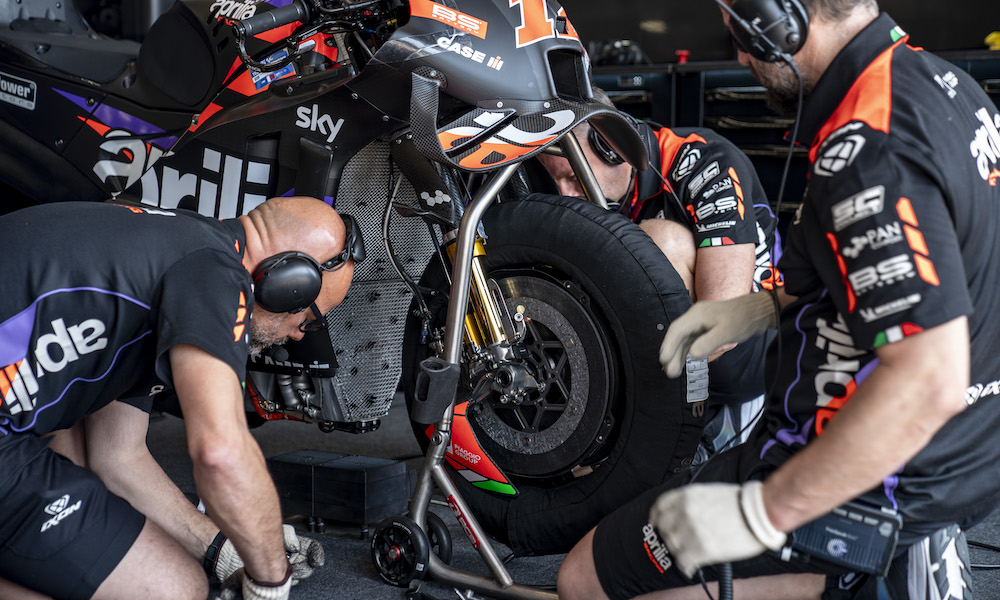
MotoGP made its one and only visit the U.S. for the Red Bull Grand Prix of The Americas at Circuit of The Americas in Austin, Texas last weekend. While we’re all awe-struck at the sight of riders holding on to a bike eclipsing 212 mph through the speed trap, it’s what happens at the end of said speed trap that is a marvel of both engineering and human athletic performance.
Some stats from MotoGP brakes supplier Brembo set the stage.
Mattia Tombolan, MotoGP Race Engineer for Brembo, states that COTA is a “3” on a scale from 1 to 6 that classifies circuits as low-braking intensity (1) to high-braking intensity (6). What determines a circuit’s braking intensity is the average heat generated over the course of a lap. Heat, or more precisely the retention of it, is the enemy of braking performance.
“At 1000 degrees Celsius (1,832 degrees Fahrenheit), the brake pads and discs begin to oxidize,” says Tombolan, “which means that the material itself starts to break down.”
Excess heat is not only detrimental to braking performance, but it can also greatly affect tire pressure and performance. As such, teams using forged magnesium front wheels by Marchesini have a specialized reflective surface coating to fur ther aid heat dissipation and keep front tire pressure stable.
A low intensity circuit would see average brake temperatures around 300 C (572 F) while a high braking intensity circuit such as the Red Bull Ring in Austria would see temps hovering around 800 C (1,472 F). COTA sits right in the middle of scale at around 550 C (1022 F).
“The single largest factor in how the brakes generate and then dissipate heat has less to do with the intensity of a single braking zone, but the frequency of braking events and the time in between them,” Tombolan explains.
At COTA there are three zones of high intensity braking in Turns 1, 11 and 12 where riders enter at over 210 mph before decelerating to 40 mph in the space of 967 feet in a time of 5.5 seconds. According to Brembo, at the same turn, Formula 1 cars start braking from a speed of 196 mph down to 53 mph in 2.78 seconds and cover a distance of 422 feet.
More remarkable still is that the act of braking is handled almost entirely by the front brake, which means that all the deceleration is handled by one tire contact patch smaller than a credit card. Unlike a car, which is mostly sprung mass balanced over four corners, some 90 percent of a MotoGP bike’s weight sits behind the front forks, which is a pivot point. If ever you’ve been traveling on a highway and witnessed an 18-wheeler semi-truck in a panic stop where the trailer suddenly swings out around the cab, that is essentially what a MotoGP rider is contending with at every braking point.
The numbers are impressive, but the question is how do they, both Brembo and the riders, do it? We start with looking at the technical angle.
Brembo are brake systems supplier to all three classes – MotoGP, Moto 2 and Moto3 – but only the MotoGP bikes use carbon discs and pads on the front brake. All classes utilize steel rotors, but only for the rear brake on MotoGP bikes.
The carbon discs and pads begin as tissue-thin sheets of carbon fiber that are stacked in layers and baked in an autoclave. Every disc and pad begin from the same batch of carbon and stay together as a set for the duration of their useful life. It takes some nine months from start to finish to manufacture each set of discs and pads.
The brake caliper assemblies are machined from billet titanium, offering a high strength to weight ratio while also being able to dissipate heat thanks to both the material properties and the complex array of cooling fins that are machined in to each one.
Depending on the circuit requirements Brembo manufacture discs in a range of diameters and thicknesses. In all, teams and riders have six carbon discs available from 355 mm diameter down to 320 mm depending on the circuit classification. At COTA, three size options were offered to choose from with 340 mm being the largest.
“From a purely braking point of view, bigger is better when it comes to the discs. Larger discs provide more surface area, creating more friction and most importantly dissipate heat faster,” says Tombolan. “The trade-off is that a larger disc generates a greater gyroscopic effect that hampers a bike and rider’s ability to change direction, limiting a rider’s choice to choose a line through a corner and most especially in combination corners requiring a shift from right to left or vice versa.”
Depending on the circuit conditions as well as other factors in bike set-up, a rider might sample from among the sizes available to find the best compromise between the bike’s handling and braking capacity.
In a future installment, we take a deep dive into how riders deploy different braking techniques such as balancing front and rear brakes, while also getting better understanding of the physicality required to make it all possible.